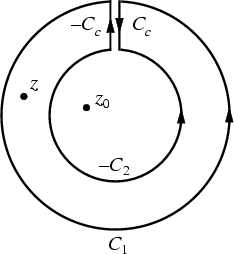Laurent Series

Let there be two circular contours ![]() and
and ![]() , with the radius of
, with the radius of ![]() larger than that of
larger than that of ![]() . Let
. Let ![]() beinterior to
beinterior to ![]() and
and ![]() , and
, and ![]() be between
be between ![]() and
and ![]() . Now create a cut line
. Now create a cut line ![]() between
between ![]() and
and ![]() ,and integrate around the path
,and integrate around the path ![]() , so that the plus and minus contributions of
, so that the plus and minus contributions of ![]() cancel oneanother, as illustrated above. From the Cauchy Integral Formula,
cancel oneanother, as illustrated above. From the Cauchy Integral Formula,
 | |||
 | |||
 | |||
 | (1) |
Now, since contributions from the cut line in opposite directions cancel out,
 | |||
 | |||
 | (2) |
For the first integral,
 | (3) |
 | |||
 | |||
 | |||
 | |||
 | (4) |
where the second term has been re-indexed. Re-indexing again,
 | (5) |
 | |||
 | |||
 | |||
 | (6) |
The only requirement on ![]() is that it encloses
is that it encloses ![]() , so we are free to choose any contour
, so we are free to choose any contour ![]() that does so. The Residues
that does so. The Residues ![]() are therefore defined by
are therefore defined by
| (7) |
References
Arfken, G. ``Laurent Expansion.'' §6.5 in Mathematical Methods for Physicists, 3rd ed. Orlando, FL: Academic Press, pp. 376-384, 1985. Morse, P. M. and Feshbach, H. ``Derivatives of Analytic Functions, Taylor and Laurent Series.'' §4.3 in Methods of Theoretical Physics, Part I. New York: McGraw-Hill, pp. 374-398, 1953.
- CRC
- Creative Telescoping
- Cremona Transformation
- Cribbage
- Criss-Cross Method
- Criterion
- Critical Line
- Critical Point
- Critical Strip
- Crook
- Crookedness
- Cross
- Cross-Cap
- Cross-Correlation
- Cross-Correlation Coefficient
- Cross-Correlation Theorem
- Cross Curve
- Crossed Ladders Problem
- Crossed Trough
- Cross Fractal
- Crossing Number (Graph)
- Crossing Number (Link)
- Cross of Lorraine
- Cross Polytope
- Cross Product